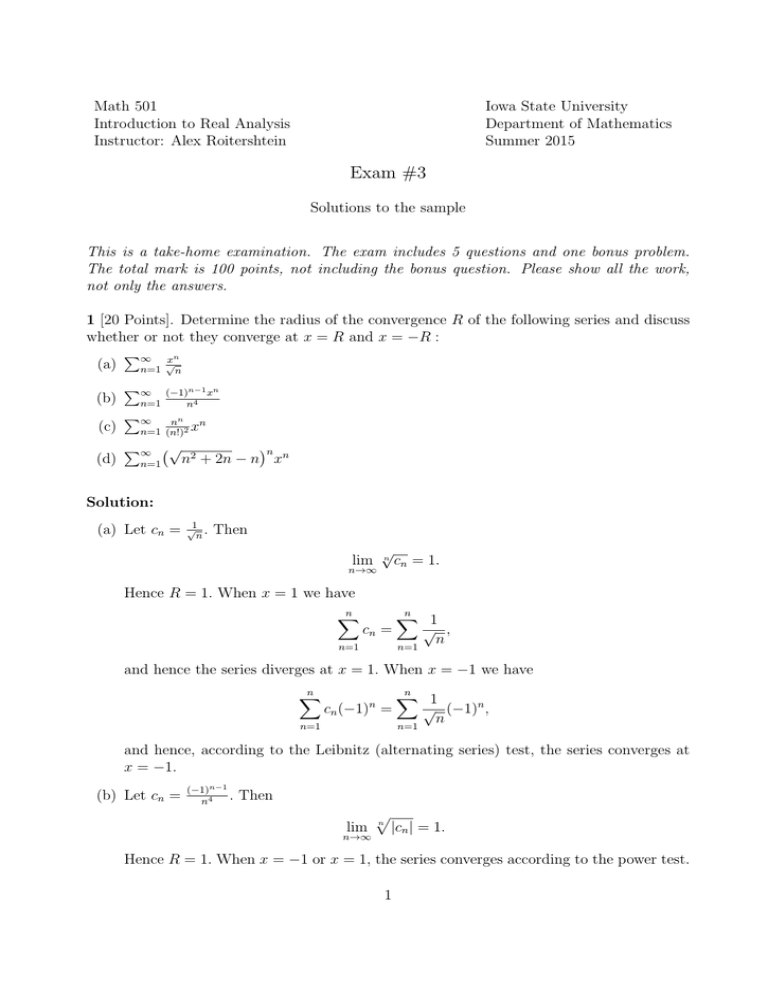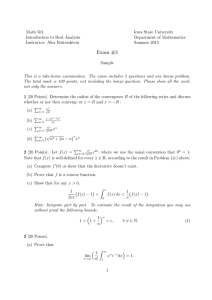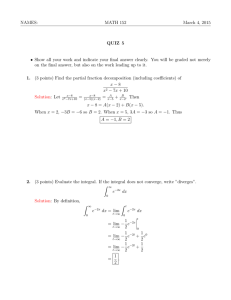Math 501 Iowa State University Introduction to Real Analysis Department of Mathematics
advertisement

Math 501 Introduction to Real Analysis Instructor: Alex Roitershtein Iowa State University Department of Mathematics Summer 2015 Exam #3 Solutions to the sample This is a take-home examination. The exam includes 5 questions and one bonus problem. The total mark is 100 points, not including the bonus question. Please show all the work, not only the answers. 1 [20 Points]. Determine the radius of the convergence R of the following series and discuss whether or not they converge at x = R and x = −R : P∞ xn √ (a) n=1 n (b) P∞ (c) P∞ (d) P∞ n=1 (−1)n−1 xn n4 nn n n=1 (n!)2 x √ n=1 n n2 + 2n − n xn Solution: (a) Let cn = √1 . n Then √ n lim n→∞ cn = 1. Hence R = 1. When x = 1 we have n X 1 √ , cn = n n=1 n=1 n X and hence the series diverges at x = 1. When x = −1 we have n X n X 1 √ (−1)n , cn (−1) = n n=1 n=1 n and hence, according to the Leibnitz (alternating series) test, the series converges at x = −1. (b) Let cn = (−1)n−1 . n4 Then lim n→∞ p n |cn | = 1. Hence R = 1. When x = −1 or x = 1, the series converges according to the power test. 1 (c) Let cn = nn . (n!)2 Then c h e 1 n n + 1 i n+1 · = lim = 0. lim = lim 1 + 2 n→∞ n + 1 n→∞ cn n→∞ n (n + 1) Hence R = +∞. √ n (d) Let cn = n2 + n − n . Then √ n lim n→∞ cn = lim n→∞ √ n2 + 2n − n = lim √ n→∞ n2 2n = 1. + 2n + n Hence R = 1. When x = 1 we have n X ck = n X k=1 k=1 n n k X 2k k X 1 k 2k √ > = 1− . 2k + 1 2k + 1 k 2 + 2k + k k=1 k=1 n 1 Since limn→∞ 1 − 2n+1 = e−1/2 6= 0, the series diverges. Similarly, since cn doesn’t converge to zero as n → ∞, the series diverges also when x = −1. P nn 2n 0 2 [20 Points]. Let f (x) = ∞ n=0 (n!)2 x , where we use the usual convention that 0 = 1. Note that f (x) is well-defined for every x ∈ R, according to the result in Problem 1(c) above. (a) Compute f 0 (0) or show that the derivative doesn’t exist. (b) Prove that f is a convex function. (c) Show that for any x > 0, 1 f (x) − 1 < 2ex Z x f (x) dx < 0 1 f (x) − 1 . x Hint: Integrate part by part. To estimate the result of the integration you may use without proof the following bounds: 1 n 1< 1+ < e, ∀ n ∈ N. (1) n Solution: (a) By Theorem 12 on p. 211 of the textbook, ∞ X nn f (x) = 2nx2n−1 . 2 (n!) n=1 0 Thus f 0 (0) = 0. 2 (b) By Theorem 12 on p. 211 of the textbook, ∞ X nn f (x) = (2n)(2n − 1)x2n−2 . 2 (n!) n=1 00 f is convex since f 00 (x) > 0 for all x ∈ R. (c) Theorem 11 on p. 211 of the textbook along with Theorem 8 on p. 208 imply that Z 0 x Z x ∞ ∞ X X nn nn 1 2n x dx = x2n+1 . f (x) dx = 2 2 (n!) 0 (n!) 2n + 1 n=0 n=0 Thus Z x ∞ ∞ X nn 1 X (n + 1)n+1 2n+2 (n + 1)2 nn 1 2n+1 f (x) dx = x = x · (n!)2 2n + 1 x n=0 [(n + 1)!]2 (n + 1)n+1 (2n + 1) 0 n=0 ∞ 1 X (n + 1)n+1 2n+2 n + 1 n n x · = (substitute k = n + 1) = x n=0 [(n + 1)!]2 2n + 1 n + 1 ∞ 1 X k k 2k k k − 1 k−1 . = x · . x k=1 (k!)2 2k − 1 k It follows then from (1) that, with n = k − 1, k k − 1 k−1 n + 1 n n n+1 1 −n = = 1+ , 2k − 1 k 2n + 1 n + 1 2n + 1 n and hence k k − 1 k−1 1 < < 1, 2e 2k − 1 k k ≥ 2. Thus Z 0 x ∞ 1 X k k 2k 1 f (x) dx < x = f (x) − 1 x k=1 (k!)2 x and Z 0 x ∞ 1 X k k 2k 1 x = f (x) − 1 . f (x) dx > 2ex k=1 (k!)2 2ex 3 [20 Points]. (a) Prove that lim n→∞ 1 Z n! ∞ n −x x e dx = 1. 1 3 (b) Prove or disprove: If a sequence of real-valued functions fn converges to f on [a, b], and Z b Z b lim fn (x)dx = f (x)dx, n→∞ a a then fn converges to f uniformly on [a, b]. Solution: (a) Let 1 fn = n! ∞ Z 1 x e dx = − n! n −x 1 Z ∞ xn (e−x )0 dx. 1 Integrating by part, we obtain fn = e−1 + fn−1 . n! Thus fn − f0 = n X (fk − fk−1 ) = k=1 n X e−1 k=1 n! , which implies fn = f0 + e−1 n n n X X X 1 1 1 = e−1 + e−1 = e−1 . n! n! n! k=1 k=0 k=1 Therefore, lim fn = lim e n→∞ −1 n→∞ n X 1 = 1. n! k=0 To verify last equality above, one can, for instance, use Taylor expansions for P∞ the xn x e = n=0 n! at x = 1. (b) Counterexample: x2 if x > 0 x + (1 − nx)2 gn (x) = x2 − 2 if x ≤ 0. x + (1 + nx)2 2 We have lim gn (x) = 0, n→∞ x ∈ R. Also, since gn is a continuous function for all n ∈ N and gn (x) = −gn (−x), we get R1 g (x) = 0 for all n ∈ N. But, for any n ∈ N, −1 n max |gn (x) − 0| = gn (1/n) = −gn (−1/n) = 1, x and hence fn does not converge to zero uniformly. 4 4 [20 points]. (a) Prove or disprove: Every point-wise converging sequence of functions fn : R → R contains a uniformly converging subsequence. (b) Construct sequences (fn )n∈N and (gn )n∈N of real-valued functions on R which converge uniformly but such that the product fn gn doesn’t converge uniformly. Solution: (a) Counterexample: fn (x) = x2 . x2 +(1−nx)2 We have x ∈ R. lim fn (x) = 0, n→∞ But, for any n ∈ N, max |fn (x) − 0| = fn (1/n) = 1, x and hence fn does not converge to zero uniformly. (b) Let fn (x) = gn (x) = ex + n−1 . Then both fn and gn converge uniformly on R to h(x) = ex . However, |fn gn (x) − e2x | = 2ex 1 + 2 n n is unbounded on R for every fixed n ∈ N, and hence fn gn does not converge uniformly to h2 (though fn gn of course converges to h2 point-wise). 5 [20 points]. Let (fn )n∈N be a sequence of real-valued continuous functions which converges uniformly on a set E. Prove that lim fn (xn ) = f (x) n→∞ for every sequence of points (xn )n∈N such that limn→∞ xn = x in E. Solution: By Theorem 1 on p. 203 of the textbook, f is continuous on E. Fix any ε > 0 and x ∈ E. Since f is continuous at x, there exists δ > 0 such that d(x, y) < δ implies |f (x) − f (y)| < ε/2. If limn→∞ xn = x, there exists N such that n > N implies both sup |fn (y) − f (y)| < y∈E ε 2 and |xn − x| < δ. Thus, for n > N we have |f (x) − fn (xn )| ≤ |f (x) − f (xn )| + |f (xn ) − fn (xn )| ≤ ≤ ε ε + = ε. 2 2 5 ε + sup |fn (y) − f (y)| 2 y∈E Hence limn→∞ fn (xn ) = f (x). 6 [Bonus question]. Prove the upper bound in (1) in the statement of Problem 2. Solution: The lower bound is trivial. We will next prove the upper bound. Define 1 n an = 1 + n . Thus f (n) = log an . It suffices to show that an is increasing and and f (x) = x log 1+x x limn→∞ log an = limx→∞ f (x) = 1. To this end, first observe that lim f (x) = lim x log(1 + x−1 ) − log 1 x→∞ t→∞ = = log(1 + t) − log 1 substitute t = x−1 lim t→∞ t 0 1 log(1 + t) t=0 = = 1. 1 + t t=0 It remains to show that f (x) is increasing for x ≥ 1. To this end observe that f (1) = log 2 and 1 1 1+x 0 +x − = sx − 1 − log sx , f (x) = log x 1+x x where sx = x 1+x ∈ (0, 1). Now, let g(s) = s − 1 − log s. Notice that g(1) = 0 and g 0 (s) = 1 − s−1 < 0, s ∈ (0, 1). Thus s ∈ (0, 1). g(s) > g(1) = 0, In particular, f 0 (x) = g(sx ) > 0, and hence f is increasing. 6







